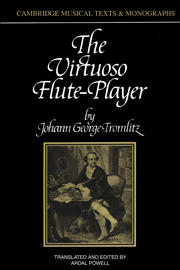Book contents
- Frontmatter
- Contents
- Translator's note
- Introduction by Eileen Hadidian
- Title in the series
- DETAILED AND THOROUGH TUTOR FOR PLAYING THE FLUTE
- Foreword
- Introduction
- 1 The flute and its character
- 2 Holding the flute, and the embouchure
- 3 Fingering
- 4 The notes and rests, their values and denominations, and the other musical signs
- 5 Time-signatures, and how the notes are divided and counted in them; the beat itself, or counting time according to an appointed tempo
- 6 Tone and pure intonation
- 7 Modern key-signatures
- 8 The articulation proper to this instrument, or the means of governing the wind suitably, as well in slow as in moderately quick movements; also called the single tongue
- 9 The technique for executing fast and very fast passages clearly and roundly; also, though improperly, called the ‘double tongue’
- 10 The ornaments
- 11 The trill
- 12 Fermatas and cadenzas
- 13 The taking of breath in flute-playing
- 14 The discretionary ornaments; or how to vary a simple melody according to the rules of harmony, and to use these variations in a good and suitable way appropriate to the material
- 15 Summary of the whole, together with a few remarks for pupils and masters
- Fingering-chart
- Select bibliography
- Index
5 - Time-signatures, and how the notes are divided and counted in them; the beat itself, or counting time according to an appointed tempo
Published online by Cambridge University Press: 01 June 2011
- Frontmatter
- Contents
- Translator's note
- Introduction by Eileen Hadidian
- Title in the series
- DETAILED AND THOROUGH TUTOR FOR PLAYING THE FLUTE
- Foreword
- Introduction
- 1 The flute and its character
- 2 Holding the flute, and the embouchure
- 3 Fingering
- 4 The notes and rests, their values and denominations, and the other musical signs
- 5 Time-signatures, and how the notes are divided and counted in them; the beat itself, or counting time according to an appointed tempo
- 6 Tone and pure intonation
- 7 Modern key-signatures
- 8 The articulation proper to this instrument, or the means of governing the wind suitably, as well in slow as in moderately quick movements; also called the single tongue
- 9 The technique for executing fast and very fast passages clearly and roundly; also, though improperly, called the ‘double tongue’
- 10 The ornaments
- 11 The trill
- 12 Fermatas and cadenzas
- 13 The taking of breath in flute-playing
- 14 The discretionary ornaments; or how to vary a simple melody according to the rules of harmony, and to use these variations in a good and suitable way appropriate to the material
- 15 Summary of the whole, together with a few remarks for pupils and masters
- Fingering-chart
- Select bibliography
- Index
Summary
The correct division of the notes and their accurate measurement is called metre; and their slowness or quickness, tempo. Although it is difficult to divide the notes according to a given tempo, it is not nearly so difficult as [determining] the correct tempo for a piece in the first place. More of this in its place.
We have two kinds of metre: duple and triple; these are either simple or compound. Duple time is when the bar can be divided into two equal parts; and triple is when it cannot. Simple duple time is either four crotchets or two crotchets. Four-four time is indicated by a latin C at the beginning of the system of staves after the clef; see x); it is also called common time, probably just as frequently as simple time. There is another time-signature which indicates four crotchets, and is denoted by a C with a line through it, see y). This time is called alla Breve or alla Capella, and goes as fast again as the normal crotchet beat, and is divided in two like the two-four time. It is used, for Fugues or fugue-like movements, but is not very suitable to the Galant style of composition. Through the ignorance of copyists, however, mistakes are often encountered, since they draw a line through the C where there should be none, or draw a line through every C.
- Type
- Chapter
- Information
- The Virtuoso Flute-Player , pp. 84 - 110Publisher: Cambridge University PressPrint publication year: 1991



